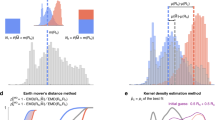Abstract
A set of formulas for the indices of the performance and predictive ability of the binary genetic tests is presented. Their dependence on disease prevalence and the population frequency of a genetic marker is characterized. It is shown that a marker with the odds ratio OR < 2.2 has an initially low prognostic efficiency in every sense and at any frequencies of the disease and the marker. A marker can be a good classifier, when OR > 5.4, but only in case its population frequency is rather high (p M > 0.3). The formulas are presented that allow obtaining indirect estimates of the absolute and relative risk of the disease for the carrier of a marker in the case-control studies.
Similar content being viewed by others
References
Aly, M., Wiklun, F., Xu, J., et al., Polygenic risk score improves prostate cancer risk prediction: results from the Stockholm-1 cohort study, Eur. Urol., 2011, vol. 60, pp. 21–28. Anonymous, How good is the test?, Bandolier J., 1996, no. 27, p. 2. http://www.medicine.ox.ac.uk/bandolier/painres/download/Bando027.pdf http://www.medicine.ox.ac.uk/bandolier/band27/b27-2.html
Banks, E., Reeves, G., Beral, V., et al., Influence of personal characteristics of individual women on sensitivity and specificity of mammography in the million women study: cohort study, Brit. Med. J., 2004, vol. 329, no. 7464, pp. 477–479.
Bjartell, A., Genetic markers and the risk of developing prostate cancer, Eur. Urol., 2011, vol. 60, pp. 29–31.
Bossuyt, P., Clinical validity: defining biomarker performance, Scand. J. Clin. Lab. Invest., 2010, vol. 70, pp. 46–52.
Cohen, J., A coefficient of agreement for nominal scales, Educat. Psychol. Measur., 1960, vol. 20, pp. 37–46.
Fawcett, T., An introduction to ROC analysis, Pattern Recogn. Letts., 2006, vol. 27, pp. 861–874.
Folsom, A., Cushman, M., Tsai, M., et al., A prospective study of venous thromboembolism in relation to factor V Leiden and related factors, Blood, 2002, vol. 99, no. 9, pp. 2720–2725.
Ioannidis, J., Commentary: grading the credibility of molecular evidence for complex diseases, Int. J. Epidemiol., 2006, vol. 35, pp. 572–577.
Jakobsdottir, J., Gorin, M.B., Conley, Y.P., et al., Interpretation of genetic association studies: markers with replicated highly significant odds ratios may be poor classifiers, PLoS Genet., 2009, vol. 5, no. 2.
King, G. and Zeng, L., Estimating risk and rate levels, ratios, and differences in case-control studies, Statistics Med., 2002, vol. 21, pp. 1409–1427.
Kraemer, H.C., Frank, E., and Kupfer, D.J., How to assess the clinical impact of treatments on patients, rather than the statistical impact of treatments on measures, Int. J. Methods Psychiatr. Res., 2011, vol. 20, pp. 63–72.
Kraft, P., Wacholder, S., Cornelis, M.C., et al., Beyond odds ratios—communicating disease risk based on genetic profiles, Nature Rev. Genet., 2009, vol. 10, pp. 264–269.
Landis, J.R. and Koch, G.G., The measurement of observer agreement for categorical data, Biometrics, 1977, vol. 33, pp. 159–174.
Levin, M.L., The occurrence of lung cancer in man, Acta Union Int. Contra Cancrum, 1953, vol. 9, pp. 531–541.
Lewontin, R.C. and Kojima, K., The evolutionary dynamics of complex polymorphisms, Evolution, 1960, vol. 14, pp. 458–472.
Linn, S. and Grunau, P.D., New patient-oriented summary measure of net total gain in certainty for dichotomous diagnostic tests, Epidemiol. Perspect. Innovat., 2006, vol. V, no. 3, p. 11. http://www.epi-perspectives.com/content/3/1/11
Mitchell, A., How to: implement a screening programme for distress in cancer settings, Psychooncology.Info.—Guide no. 101, 2009a. http://www.psychooncology.info/PG-implement-ajmitchell.pdf
Mitchell, A., How to: analyse a screening or diagnostic study, Psychooncology.Info.—Guide no. 104, 2009b. http://www.psycho-oncology.info/PG-analyse-ajmitchell.pdf
Pepe, M.S., Gu, J.W., and Morris, D.E., The potential of genes and other markers to inform about risk, Cancer Epidemiol. Biomarkers Prevent., 2010, vol. 19, pp. 655–665.
Poste, G., Bring on the biomarkers, Nature, 2011, vol. 469, pp. 156–157.
Sistrom, C.L. and Garvan, C.W., Proportions, odds, and risk, Radiology, 2004, vol. 230, pp. 12–19.
Slatkin, M., Linkage disequilibrium—understanding the evolutionary past and mapping the medical future, Nature Rev. Genet., 2008, vol. 9, pp. 477–485.
Spielman, R.S., McGinnis, R.E., and Ewens, W.J., Letter to the editor: the transmission/disequilibrium test detects cosegregation and linkage, Am. J. Human Genet., 1994, vol. 54, pp. 559–560.
Swets, J.A., Measuring the accuracy of diagnostic systems, Science, 1988, vol. 240, pp. 1285–1293.
Tan, P.N., Kumar, V., and Srivastava, J., Selecting the right objective measure for association analysis, Inform. Syst., 2004, vol. 29, pp. 293–313.
Winham, S.J., Slater, A.J., and Motsinger-Reif, A.A., A comparison of internal validation techniques for multifactor dimensionality reduction, BMC Bioinform., 2010, vol. 11, p. 394. http://www.biomedcentral.com/1471-2105/11/394
Youden, W.J., Index for rating diagnostic tests, Cancer, 1950, vol. 3, pp. 32–35.
Yule, G.U., On the methods of measuring association between two attributes, J. Royal Stat. Soc., 1912, vol. 75, pp. 579–652.
Zhang, J. and Yu, K.F., What’s the relative risk? A method of correcting the odds ratio in cohort studies of common outcomes, J. Amer. Med. Assoc., 1998, vol. 280, pp. 1690–1691.
Author information
Authors and Affiliations
Corresponding author
Additional information
Original Russian Text © A.V. Rubanovich, N.N. Khromov-Borisov, 2013, published in Ekologicheskaya Genetika, 2013, Vol. 11, No. 1, pp. 77–90.
Rights and permissions
About this article
Cite this article
Rubanovich, A.V., Khromov-Borisov, N.N. Theoretical analysis of the predictability indices of the binary genetic tests. Russ J Genet Appl Res 4, 146–158 (2014). https://doi.org/10.1134/S2079059714020087
Received:
Accepted:
Published:
Issue Date:
DOI: https://doi.org/10.1134/S2079059714020087




